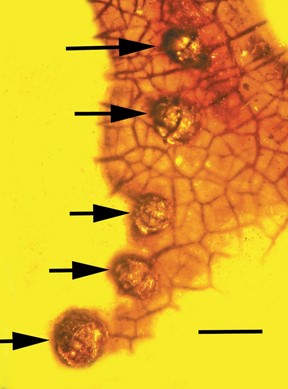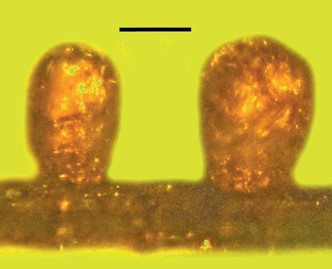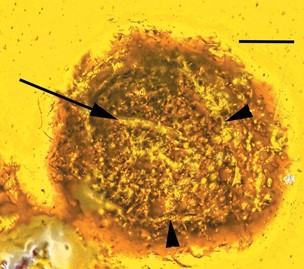Palaeomycus epallelus Poinar gen. and sp. nov. (Figures 1–6)
MycoBank number: MB 823324; Index Fungorum number: IF 823324; Facesoffungi number: FoF;
Etymology: From the Greek ‘epallelos’ = in sequence, referring to the nearly equal continuous rows of conidia aligned in unbroken succession.
Type material: Holotype deposited in the Poinar amber collection (accession # B-F- 5) maintained at Oregon State University.
Type locality: Hukawng Valley southwest of Maingkhwan in Kachin State (26º20´N, 96º36´E), Myanmar.
Description: Pycnidia superficial, from 660 µm to 860 µm in greatest diameter; 514 µm to 914 µm in height above leaf surface. Conidiophores 40 µm to 42 µm in length, arranged in rows, with single or branched tips bearing terminal oval to ellipsoidal conidia from 4–6 µm in greatest dimension.

Figure 1. Angiosperm leaf portion with dorsal view of 5 pycnidia (arrows) of Palaeomycus epallelus gen. and sp. nov. in Myanmar amber. Scale Bar = 822 µm.

Figure 2. Lateral view of two pycnidia of Palaeomycus epallelus gen. and sp. nov. in Myanmar amber. Scale Bar = 400 µm.

Figure 3. Single pycnidium of Palaeomycus epallelus gen. and sp. nov. in Myanmar amber. Arrowheads show edge of ostiole. Arrow shows a small arthropod. Scale Bar = 190 µm.

Figure 4. Unbroken succession of conidiophores and conidia of Palaeomycus epallelus gen. and sp. nov. in Myanmar amber. Scale Bar = 23 µm.

Figure 5. Portion of a row of conidiophores bearing conidia of Palaeomycus epallelus gen. and sp. nov. in Myanmar amber. Arrowhead shows two-spored conidiophore. Scale Bar = 11 µm.

Figure 6. Portion of a row of conidiophores bearing conidia of Palaeomycus epallelus gen. and sp. nov. in Myanmar amber. Arrowhead shows a conidiophore with several branches, each bearing a conidium. Scale Bar = 9 µm.
